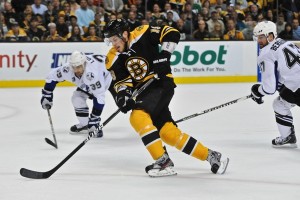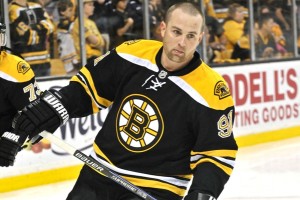By Mike Miccoli, Boston Bruins correspondent

There isn’t much to say about the 2013 Boston Bruins that hasn’t already been said—and that’s not necessarily a bad thing.
Prior to Tuesday night’s 4-3 shootout loss to the New York Rangers, the team was off to its best ten-game start in franchise history (8-1-1) behind a torrid goaltender tandem, contributions from all four lines and shrewd coaching from Claude Julien. For right now, the players are clicking and the Bruins are quickly becoming powerhouses of the Eastern Conference. So why does it feel like something is missing?
Because there is.
The Bruins’ power play has been a punch line around Boston for the past three seasons. Recall back to the 2011 postseason where the Bruins became the first team ever to advance in a playoff round without scoring once with a man-advantage. The Bruins were 0 for 21 on the power play and yet still managed to squeak out an overtime win in Game 7 to eliminate the Montreal Canadiens and eventually become Stanley Cup Champions. They finished with 10 power play goals that postseason in 88 chances—88! Their percentage on converting while up a skater was better than only the Penguins and the Rangers, neither of which team played more than seven games. The Bruins played 25.
It was a joke. No, really…it was a big joke. The “Bruins are 0 for Eddie Shore, Bobby Orr (and so on) on the power play!” tweets got old pretty quickly, especially once they hit older, more obscure players’ numbers (Michael Thelven, Craig Jenney and Stephane Richer were all accounted for, don’t worry). But regardless of the 2011 postseason, there has been one constant with the Bruins’ power play since the 2005-06 season—it’s always been pretty brutal.
Before you can fix the Bruins’ power play, you need to be able to diagnose the issues. For one, the Bruins power play has always been bad. Aside from a fluke season in 2008-09, the Bruins power play usually stinks, ranking in the lower half in the NHL almost annually since the 2005-06 season. Second, the Bruins have never been known for their elite goal scoring–why should their time with the man-advantage be any different? And most importantly, the Bruins power play doesn’t happen very often at all, actually.
In the past six seasons, the Bruins have consistently been in the bottom five in power-play opportunities in the NHL. During the 2009-10 season, only Montreal had a fewer amount of power play opportunities (261) than the Bruins (265). So far in this shortened 2013 NHL season, the Bruins are in the bottom-five in opportunities once again.
It’s not that the Bruins don’t get enough chances to score; it’s the severe lack of production that continues to haunt the team. Boston scored 44 power play goals in 2009-10 (27th in the NHL) and 43 in both 2010-11 (26th) and 2011-12 (22nd). In comparison, the Bruins were last in the league with 136 goals scored at even strength in 2009-10, but were the best team in the NHL at five-on-five hockey in 2010-11 with 177 goals and then again in 2011-12 with 193.
For reference, in 2008-09 the Bruins scored 74 goals (5th in the NHL) in 313 opportunities (27th) resulting in a 23.6% success rate with the man-advantage, fifth best in the NHL. They were also second in the league with 171 goals-for at even strength. In the larger scope, this seemed to have been a one-off occurrence but there had to have been something that was making the Bruins so successful on the power play.
So what changed? A lot.

The most obvious is the loss of Marc Savard. Savard was atop the power play point totals in 2008-09, when the Bruins had one of their most productive seasons on the man-advantage. The center scored nine goals and assisted on 21 others while patrolling the half-wall on the power play. He was second in ice-time on the team spending an average of 3:42 per game on the man-advantage. Only Zdeno Chara (3:46) had more.
Savard’s production deteriorated once he became injured, of course. Even when playing 41 games in 2009-10, Savard still led all Bruins on the power play with six goals and 11 assists and a team-high 3:17. If that doesn’t clearly give you an idea of how big of a void is left without Savard, I’m not sure what will.
Currently, the Bruins do not have a forward who can play the half-wall and find open passing lanes as efficiently as Savard. Patrice Bergeron has tried, but in the past four seasons, the 2012 Selke Trophy winner was only in the top five for scoring on the power play once, despite consistently being in the top five for average time-on-ice during the man-advantage. Because of this, Chara’s production has tapered off as well. Chara scored 11 goals and had 28 points on the power play in 2008-09 and has slipped since, with fewer short, crisp passes being fed to him. Factor in the losses of Dennis Wideman, Mark Recchi and Michael Ryder, all of which were in the top five in scoring on the power play during their time in Boston, and it’s evident to see why the Bruins have been struggling.
Not all hope is lost, though. The Bruins could be in somewhat of a bridge year or two as they wait for the developments of guys like Tyler Seguin and Dougie Hamilton; both of whom will no doubt bring welcomed assistance to the power play units as they grow as players. Both played on Boston’s top power play unit on Tuesday night when the Bruins continued their lack of success by going 0-for-4 with the man-advantage. Last year, Seguin was second in points on the power play, scoring five goals and assisting on ten others in 81 games. But he wasn’t even in the top five for average time-on-ice for the man-advantage.
Geoff Ward, who oversees the Bruins’ special teams’ unit, has to better manage the time for some of his players. There is little to no correlation between those who are spending the most time on the ice during the power play to those who are contributing the most points anymore. It happened with Seguin in 2011-12, Ryder in 2010-11 and David Krejci in 2009-10: less time-on-ice during the power play, equaled more production.
Along with posting a Bruin on the half-wall, Boston focuses on a pass-first offense that leads to multiple attempts before finding an open man with a clear shooting lane. Past strategies have also focused on Chara rushing to the net for a screen. That’s a start to what the Bruins should be doing.
It’s time for Seguin to start emulating Savard and start playing the half-wall with Chara on the point. Big-bodied guys like Nathan Horton and Milan Lucic can set up a screen and Krejci can be directing from deep in the zone. Sure, Krejci and Seguin can be inter-changeable but the one thing that Seguin has developed this year, almost overwhelmingly, is a better sense of where his teammates are on the ice at all times; a skill that could help immensely on the power play.
On the second unit, Rich Peverley should continue to be given a serious look to play a similar role to Krejci’s. Peverley actually led all Bruins in time-on-ice during the power play (2:44) and scored a goal with ten assists in 57 games. That would have been good enough for fourth best on the team, tied with Krejci and Lucic who played 79 and 81 games apiece. His ten assists matched a team-high with Chara and Seguin. Obviously Bergeron should be on the ice, and maybe Brad Marchand too. On the point, Dennis Seidenberg should be a mainstay (even though he’s a player where time-on-ice and production totally miss parallels) and a swap between Hamilton and Johnny Boychuk’s shot.
It seems easy enough to fix and looks good enough on paper, but for whatever reason, the power play unit can’t seem to get it done. The Bruins are fortunate enough to be a strong five-on-five team to survive and are looking to continue that trend during the 2013 NHL season but there’s no doubt that their lack of production on the power play is now harming the team.
Follow Mike on Twitter for more Bruins updates, news and commentary.